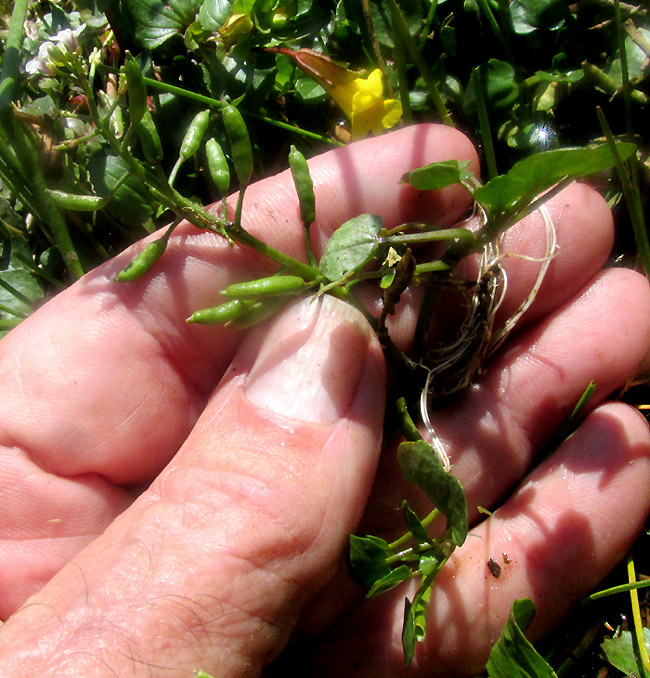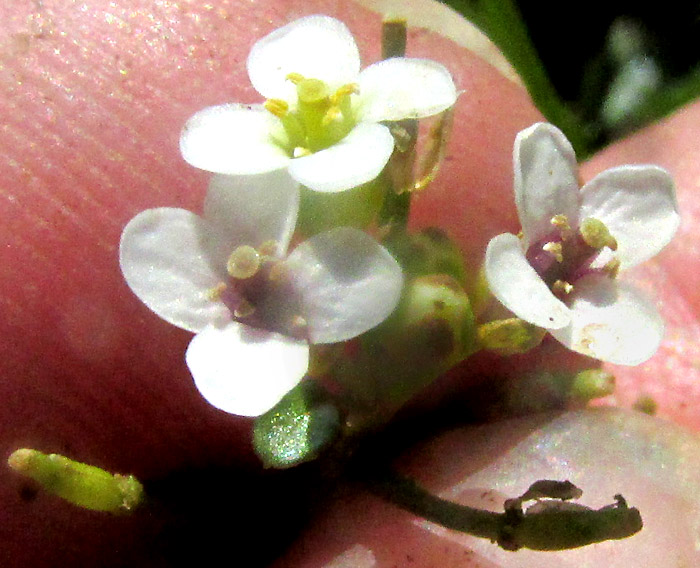Excerpts from Jim Conrad's
Naturalist Newsletter
Entry dated November 7, 2023, from notes taken at Cascadas de La Piedad waterfall 3kms NW of the community of San Pablo, municipality of Almeaco de Bonfil; bedrock of igneous andesite; N20.1008°, W100.0041°, elevation 2360 meters (7750ft); extreme southern Querétaro state, MÉXICO
WATERCRESS

Even during the ongoing two-year dry period classified by the "North American Drought Monitor" as an extreme D3 drought, a small stream of clear, cold water meandered across a livestock-grazed meadow atop a bed of pinkish, igneous andesite rock. Just before tumbling over a high ledge to create the picturesque Cascada de La Piedad, or Piety Waterfall, the above somewhat succulent, ankle-high herb was entangled with other species at the water's edge, some of its hollow stems floating atop the water.
Less striking than the yellow flower in the background, of the Round-leaf Monkeyflower, is the plant in my hand. Its small, white flowers cluster at the raceme-type inflorescence's top, seen in the picture's top, left corner. Below the flowers, capsular-type fruits were developing. At nodes along floating parts of the stem, long, white, adventitious roots had developed. The plant's leaves at first appeared to consist of small, roundish, undivided blades at the tips of long petioles, and that was the case with a few, but most lower leaves were divided into 3 or more leaflets.

Flowers with four petals and six stamens, with two of the stamens markedly shorter than the others -- that immediately brings to mind the important Mustard Family, the Brassicaceae, the home of cabbage, kale, broccoli, cauliflower, turnips, radishes, horseradish, canola or rape, and many other species, including ornamentals such as alyssum, and wildflowers as well as roadside weeds. Mustard Family species occur nearly worldwide, but mainly in temperate zones. The family's centers of diversity are in the Irano-Turanian Region, the Mediterranean and western North America.
Different from most families of flower plants, in the Mustard Family, often identification to genus level depends more on the capsular fruit's structure than flower anatomy.

Our plant's immature fruits, shown at the right are, a special kind of capsule-type fruit known as siliques. Siliques are long, narrow fruits which split open when mature. Many Mustard Family fruits are short, as with the weedy peppergrasses, which of course aren't grasses at all. And many produce siliques which are much more slender than our plant's, as with the London Rocket weed. Our plant's siliques are topped with short, stubby styles, and are somewhat knobby or "torulose" -- swollen and constricted at intervals.
In our part of upland central Mexico, if you have a hairless, semiaquatic, white-flowered member of the Mustard Family member whose fruits are more than four times longer than wide and bear pointy tops which are NOT clearly more than just short styles, and at least some of the leaves are divided into not more than seven leaflets, you have NASTURTIUM OFFICINALE, the famously edible herb known as Watercress.
Watercress, a native of Eurasia, is one of the oldest known leaf vegetables eaten by humans. Its leaves, stems and fruits are eaten raw, steamed or cooked, and large farms cultivate it for that purpose. Nutritionally, it's particularly high in vitamin K, as well as having significant amounts of vitamins A, C, B2 and B6, plus calcium and manganese. However, Watercress is 95% water, providing very little carbohydrate, protein, fat or fiber.
Despite Watercress having been introduced into the Americas and the rest of the world from Eurasia, it's been established in Mexico long enough not only for indigenous people to have a long history of eating it, but to regard it as an important medicinal plant. The online Atlas de las Plantas de la Medicina Tradicional Mexicana , which calls it berro, reports that in upland central Mexico, where it's called berra, the entire plant with or without roots is ground up or chopped and eaten for kidney pains. In Durango it's chopped up and once a day eaten with lemon for tuberculosis. In Mexico City, stems and leaves eaten daily in salads is thought to be good for the heart. Also it's sometimes used for liver problems, inflamed mouth, ulcers, to bring on menstruation, to purify the blood, relieve shoulder pain, and deal with hepatitis, diabetes, and more.
In fact, in the 2020 study by Ali Esmail Al-Snafi entitled "A review on Nasturtium officinale: A potential medicinal plant," it was concluded that a large body of pharmacological studies reveals that "...Nasturtium officinale possessed hypolipidemic, anti-inflammatory, hepato and reno protective, antidiabetic, antioxidant, anticancer, antimicrobial, dermatological, antigenotoxic, anti-urolithiatic and antigenotoxic effects."
Watercress's identity can be confusing. Some authors and older literature refer to Nasturtium officinale as Rorippa nasturtium-aquaticum. The species was first named by Linnaeus in 1753, but he placed the species in the genus Sisymbrium. Later other authorities shifted the species to various other genera, more recently into Rorippa. But lately the consensus of most experts appears to have become that it's a Nasturtium. Kew's Plants of the World database currently lists 48 synonyms for Nasturtium officinale. Adding to the confusion, the popular garden vine known as Nasturtium, bearing large, colorful blossoms and round leaves which also are highly edible, is a member of the genus Tropaeolum, of the Tropaeolum Family.